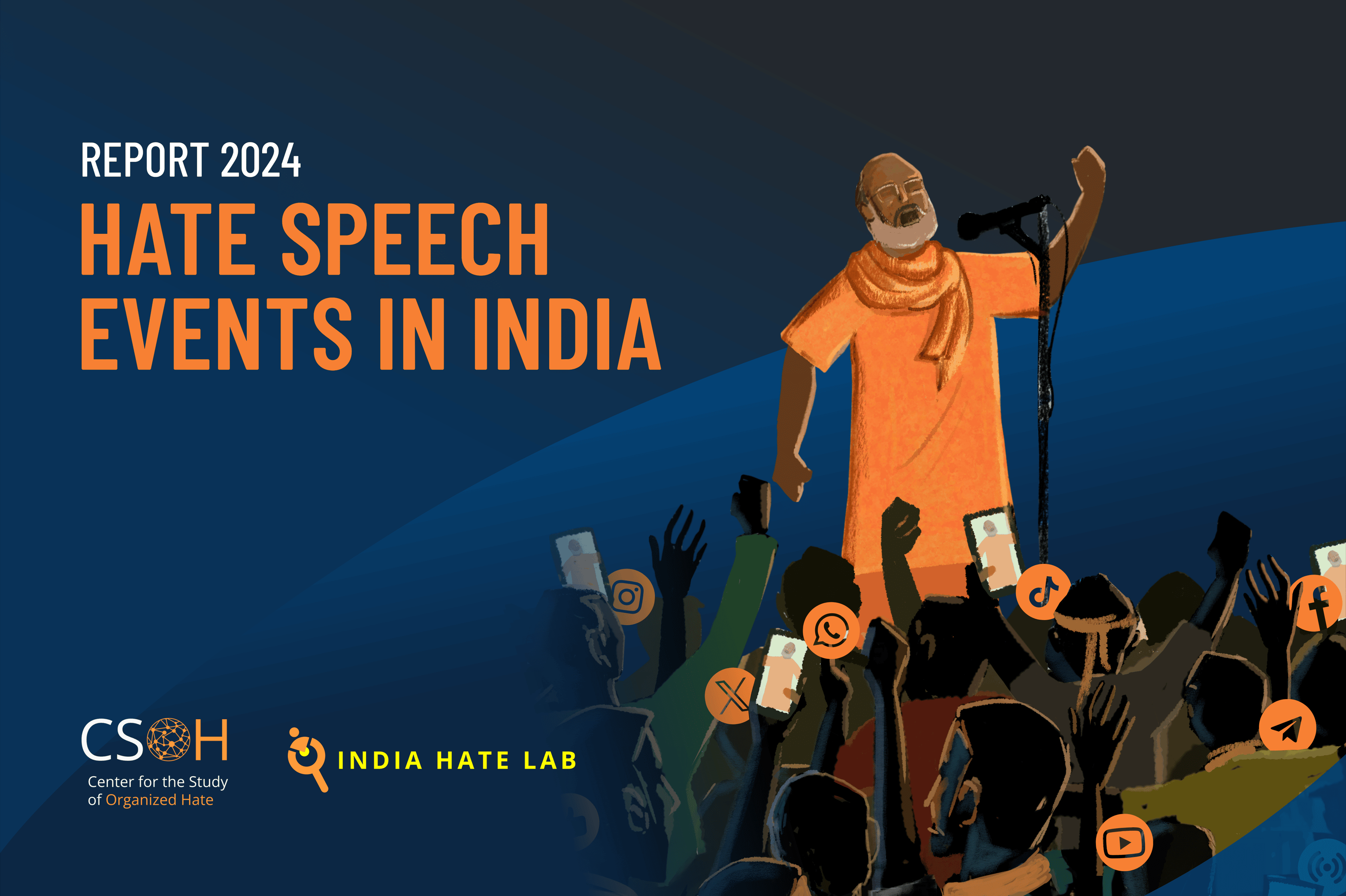Introduction
This report documents and analyzes verified instances of in-person hate speech events in India in 2024, covering various types of mass gatherings. These include political rallies, electoral campaign events, religious processions, protest marches, demonstrations, and cultural or nationalist gatherings. In other instances, they are organized with the express objective of harassing minorities. In 2024, the Indian general election, state elections in Maharashtra and Jharkhand, and hate rallies triggered by exaggerated claims of violence against Hindus in Bangladesh served as key catalysts for a significant proportion of hate speech incidents.
Hate speech in India in 2024 followed an alarming trajectory, deeply intertwined with the ideological ambitions of the ruling Bharatiya Janata Party (BJP) and the broader Hindu nationalist movement. The number of hate speech incidents targeting religious minorities surged from 668 in 2023 to 1,165 in 2024, marking a staggering 74.4% increase. Dangerous speech—defined as speech that “increases the risk that its audience will condone or participate in violence against members of another group”—also saw a significant rise.
Patterns of hate speech in 2024 reflect both continuity and transformation in its context and content with longstanding Hindu nationalist tropes remaining dominant—such as the portrayal of Muslims and Christians as “outsiders” in Hindu India and Muslims as a threat to Hindus. Hate speeches frequently invoked the narrative of Muslims as “infiltrators,” linked to thinly veiled allegations of all Indian Muslims as Bangladeshi migrants or Rohingya refugees. Hindu far-right leaders demonized Indian Muslims as parasitic and thieving, alleging that they were either wrongfully granted resources that rightfully belonged to Hindus or were stealing Hindu wealth through acts of aggression. These rhetorical shifts reinforced exclusionary narratives, further escalating anti-minority sentiment and hostility.
The fact that 2024 was a general election year in India, with polling held in seven phases between April 19 and June 1, played a crucial role in shaping the patterns of hate speech incidents compared to 2023. A notable peak in hate speech occurred in May 2024, at the height of the election process. As was the case for the entire year, political leaders from the BJP, as well as religious leaders and figures associated with the Vishwa Hindu Parishad (VHP), Bajrang Dal, and other Hindu nationalist organizations, were responsible for an overwhelming number of hate speech incidents during this period.
A notable shift in 2024, compared to 2023, was the central role played by top BJP leaders and national figures in propagating hate speech. While state-level politicians dominated the list in 2023, 2024 saw national leaders emerge as key instigators of communal rhetoric. Among the most prominent figures responsible for significant numbers of hate speech incidents were Prime Minister Narendra Modi, Home Minister Amit Shah, Uttar Pradesh Chief Minister Yogi Adityanath, Assam Chief Minister Himanta Biswa Sarma, Telangana BJP legislator T. Raja Singh, and Maharashtra BJP legislator and Minister of Fisheries and Port Development Nitish Rane.
The dynamics of hate speech in 2024 reflected both top-down and bottom-up trends. National leaders like Modi and Shah, along with powerful regional figures such as Adityanath and Sarma, were able to reach nationwide audiences, even when their speeches were delivered in the context of local election campaigns. These high-profile hate speeches were further amplified and reinforced by an arsenal of local BJP leaders, Hindu far-right organizations, and religious figures, who spread similar rhetoric at community and grassroots levels. This interplay between top-down and bottom-up hate speech flows helped saturate political discourse with narratives that vilified and threatened Muslims, effectively crowding out space for meaningful democratic debate.
A second peak in hate speech events occurred in August 2024 with the fall of the Sheikh Hasina government and the ensuing political crisis in Bangladesh. The specter of the Hindu minority community being under attack in Bangladesh provided rich fodder for anti-Muslim rhetoric and hate in India. Though the Hindu minority in Bangladesh did face violence, the BJP, Hindu nationalist groups, supporters, and Indian news outlets engaged in a disinformation campaign over the scale and scope of attacks on the community.
Hate speech patterns in 2024 also revealed a deeply alarming surge in dangerous speech compared to 2023, with both political leaders and religious figures openly inciting violence against Muslims. This included calls for outright violence, calls to arms, the economic boycott of Muslim businesses, the destruction of Muslim residential properties, and the seizing or demolition of Muslim religious structures. In many instances, incitement to violence was framed as either retribution for alleged historical wrongs committed by Muslim rulers or “invaders” against Hindus or as a preemptive measure to counter an imagined Muslim threat.
Social media platforms—Facebook, Instagram, WhatsApp, YouTube, Telegram, and X (formerly Twitter)—have been key instruments in enabling, amplifying, and mainstreaming hate speech and extremist ideologies, both in India and globally.In the Indian context, these platforms have been extensively utilized to articulate and spread Hindu nationalist ideology and anti-minority rhetoric. Of the 1,165 in-person hate speech events targeting Muslim and Christian minorities in 2024, 995 videos were traced back to their original sources on social media, where they were first uploaded or live streamed. Facebook and YouTube emerged as major platforms for dissemination, with Facebook alone accounting for 495 hate speech videos, while 211 videos were exclusively shared on YouTube. Notably, 266 anti-minority hate speeches delivered by senior BJP leaders—primarily during the April–June general elections—were simultaneously live streamed across YouTube, Facebook, and X through the official accounts of the party and the leaders.
Given the logic of virality, social media platforms facilitate the rapid and widespread circulation of hateful content while also elevating the most extreme instances of hate speech through algorithmic amplification. Despite their own community standards prohibiting hate speech, social media platforms failed to enforce their guidelines, allowing violative content to spread unchecked.
Viewed cumulatively, shifts in hate speech patterns in 2024 reinforced and amplified the core tenets of the Hindu nationalist worldview, that is, the idea of India as an exclusively Hindu nation with minorities, especially Muslims and Christians, as perpetual outsiders. Muslims, in particular, were portrayed as an existential threat to Hindus and the Indian nation. Hate speech events were embedded within elaborate conspiracy theories and allegations of various “jihads” to dominate, convert, defile, and seduce Hindus. These narratives were designed to stoke a strong sense of Hindu victimhood and, consequently, to justify the exclusion and marginalization of minorities and acts of violence against them. The sharp spike in the rise of hate speech events points to the incorporation of hate speech as part of routine electoral politics and campaign strategy. It is also indicative of an increasingly aggressive assertion of Hindu nationalism in public and political life. As of 2024, Hindu nationalism has taken on a much more extreme form, with its rhetoric becoming more blatant, inflammatory, and violent. Marking a continuity with past trends, hate speech in 2024 contributed to an environment where increasingly egregious expressions of hate and violence against Indian minorities continued to be normalized.
Key Findings
- India Hate Lab (IHL), a project of the Center for the Study of Organized Hate (CSOH), documented 1,165 in-person hate speech events targeting religious minorities, particularly Muslims and Christians, in 2024 across 20 states, two union territories, and the National Capital Territory (NCT) of Delhi. On average, three hate speech events were held per day. This marks a 74.4% increase from 2023, when 668 such incidents were recorded.
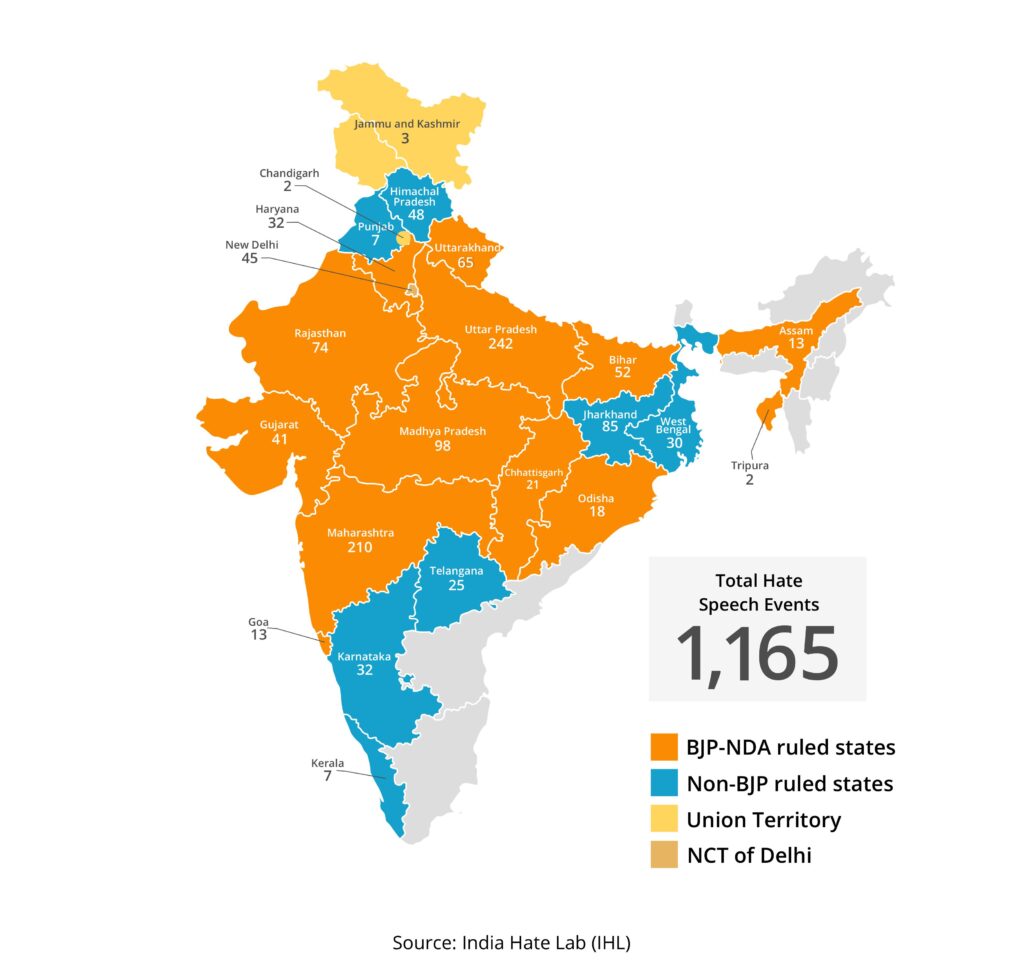
- 1,147 (98.5%) speeches targeted Muslims—either explicitly (1,050) or alongside Christians (97)—while 115 (9.9%) targeted Christians, either explicitly (18) or alongside Muslims (97).
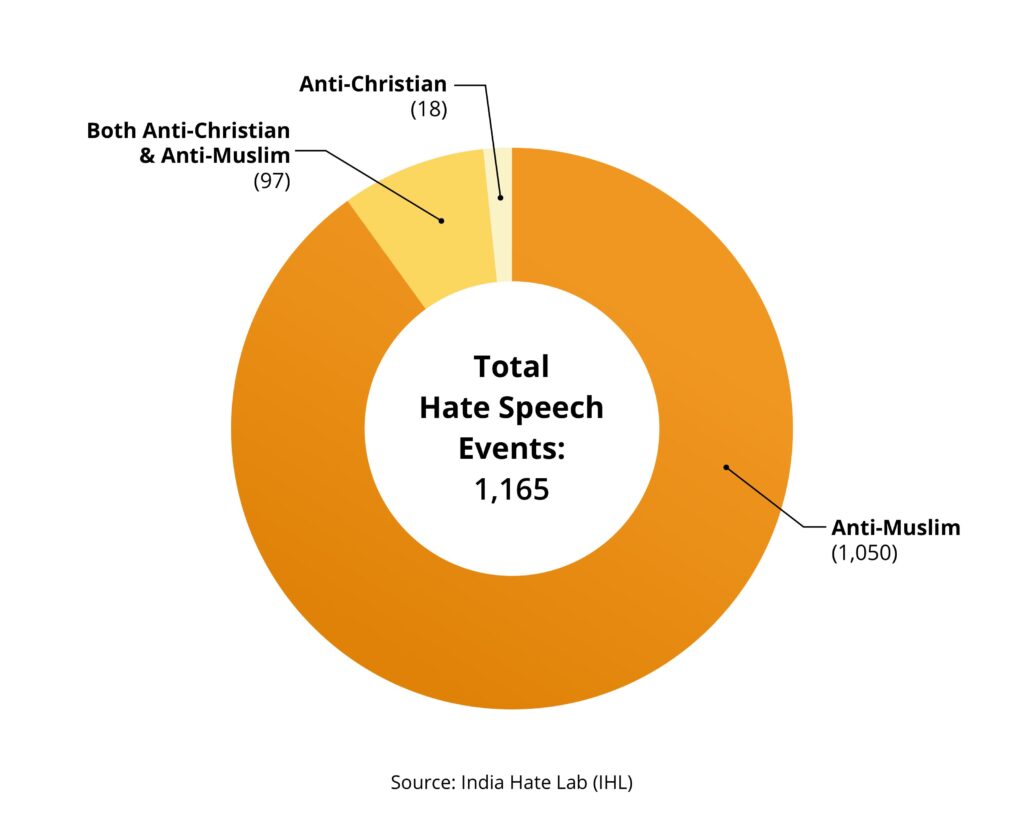
- 931 (79.9%) hate speech events took place in states ruled by the Bharatiya Janata Party (BJP), the National Democratic Alliance (NDA), or in union territories where the police and public order is under the purview of the BJP-led central government. The opposition ruled states recorded 234 (20%) hate speech events.
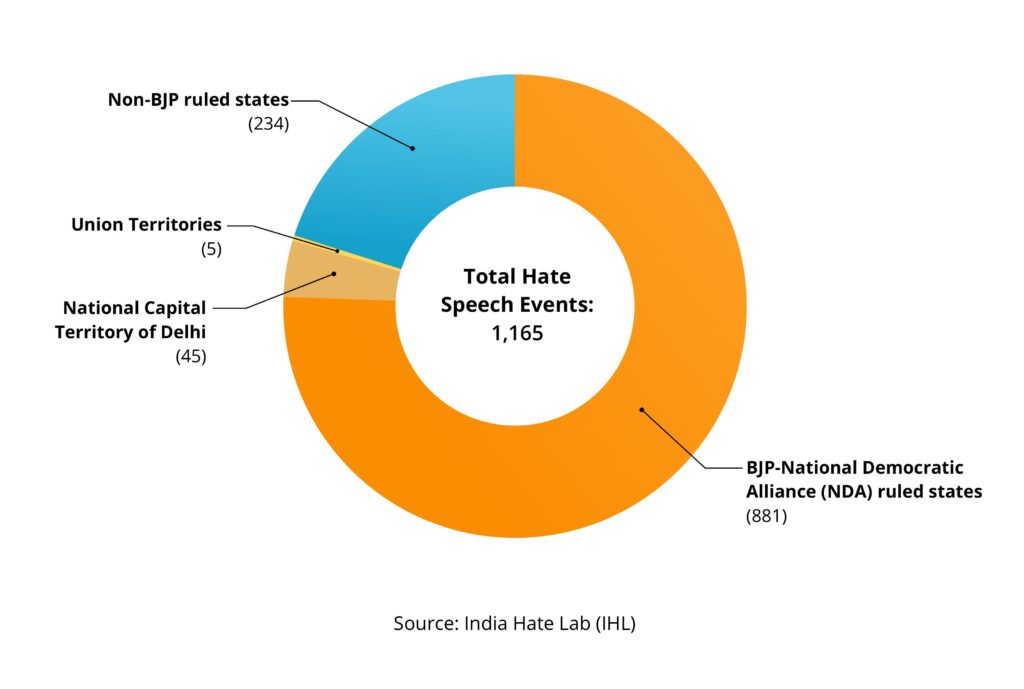
- Uttar Pradesh (242), Maharashtra (210), and Madhya Pradesh (98) ranked top among states for hate speech events. These three states, ruled by the BJP and their allies, collectively accounted for 47% of the total hate speech events recorded in 2024.
- BJP directly governed or ruled in coalition in seven of the ten states with the highest hate speech incidents.
- 340 (29.2%) hate speech events were organized by the BJP, making it the most frequent organizer in 2024, with most events occurring during the general election campaign. This marks a 580% increase from 2023, when the party organized 50 such events.
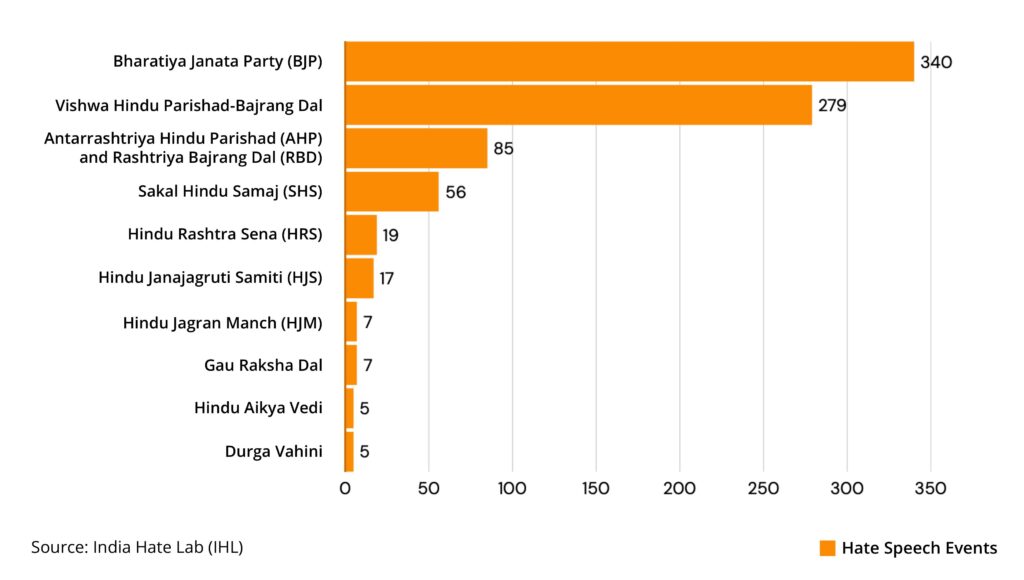
- 685 (58.8%) hate speech gatherings were organized by entities that are part of the broader Sangh Parivar (the Rashtriya Swayamsevak Sangh family), including the Vishwa Hindu Parishad-Bajrang Dal, the BJP, the Sakal Hindu Samaj (SHS) and Durga Vahini.
- 462 (39.7%) hate speeches were delivered by politicians. BJP leaders were responsible for 452 of these speeches. Compared to 2023, when BJP politicians delivered 100 hate speeches, this represents an increase of 352%.
- Six of the ten most frequent purveyors of hate speech were politicians, including Chief Minister Yogi Adityanath, Prime Minister Modi and Home Minister Amit Shah. Adityanath delivered 86 (7.4%) hate speeches, while Modi delivered 63 hate speeches, accounting for 5.7% of all such speeches in 2024.
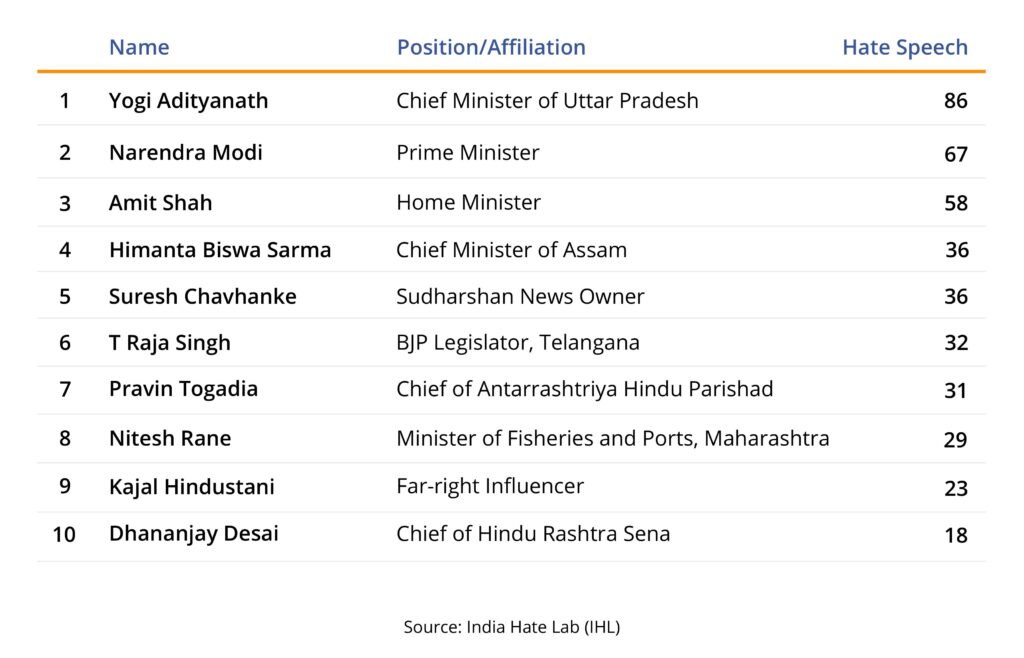
- 373 (32%) of all hate speech events took place during the 2024 general election, between March 16, when the Model Code of Conduct (MCC) went into effect, and June 1, the last phase of elections.
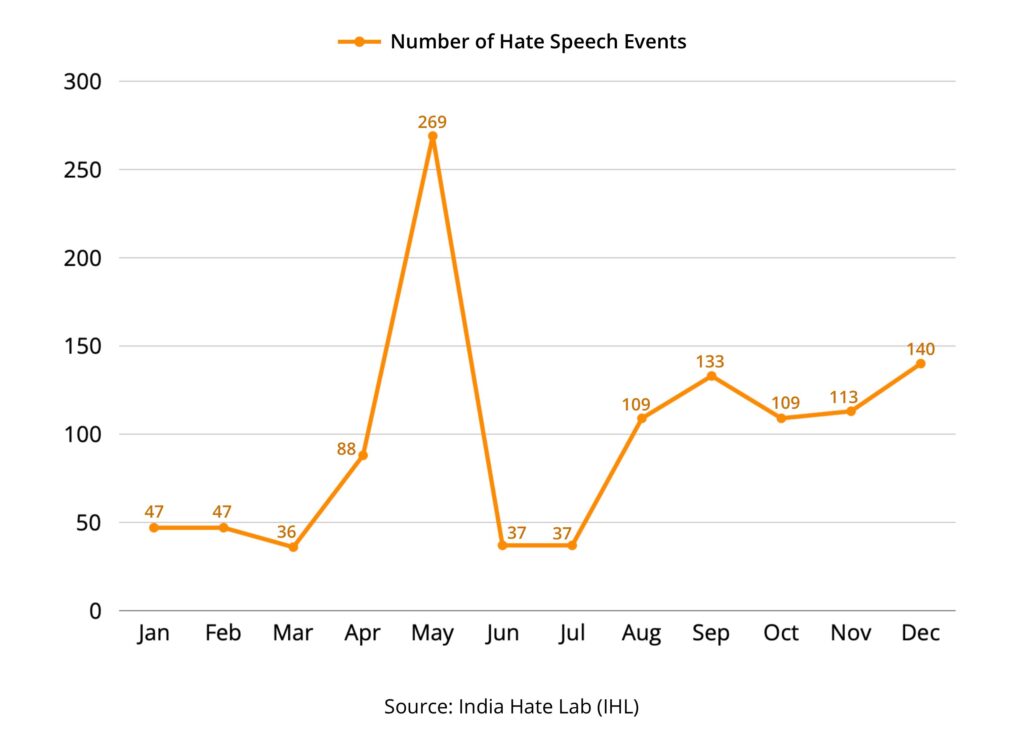
- 114 (9.8%) hate speeches were delivered by Hindu religious preachers, with Mahant Raju Das, Yati Narsinghanand Saraswati, and Sadhvi Saraswati among the key figures.
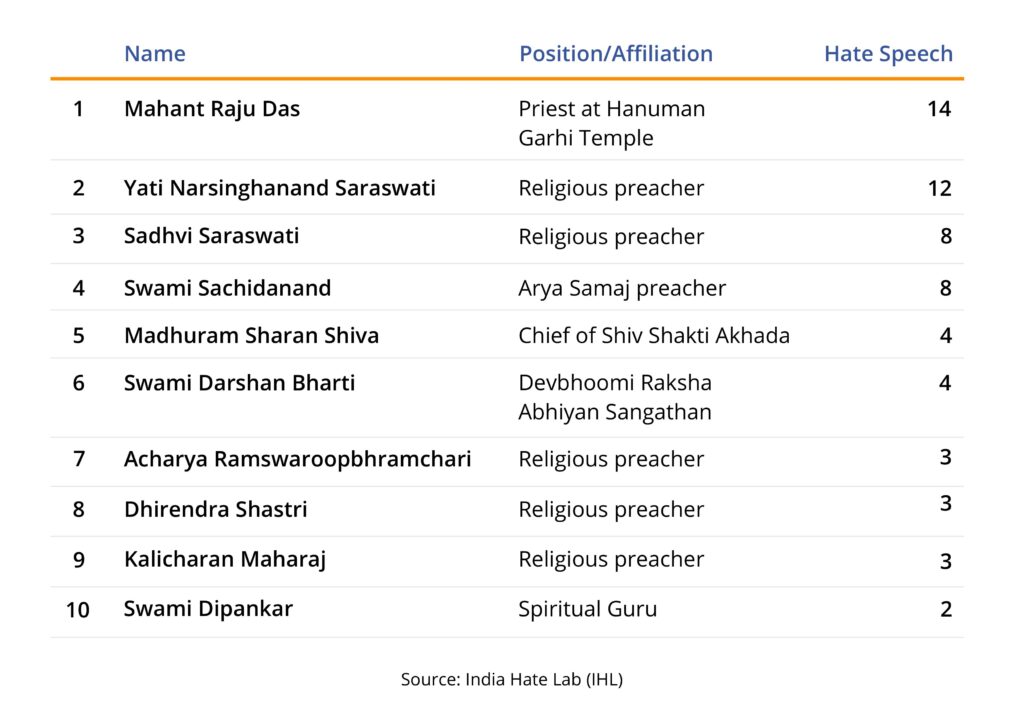
- 581 (49.9%) incidents of hate speech in our data set referenced common far-right conspiracy theories, including, but not limited to, “love jihad,” “land jihad,” “population jihad,” and “vote jihad.” Compared to 2023, hate speech events with conspiracy theories increased by 38.3%.
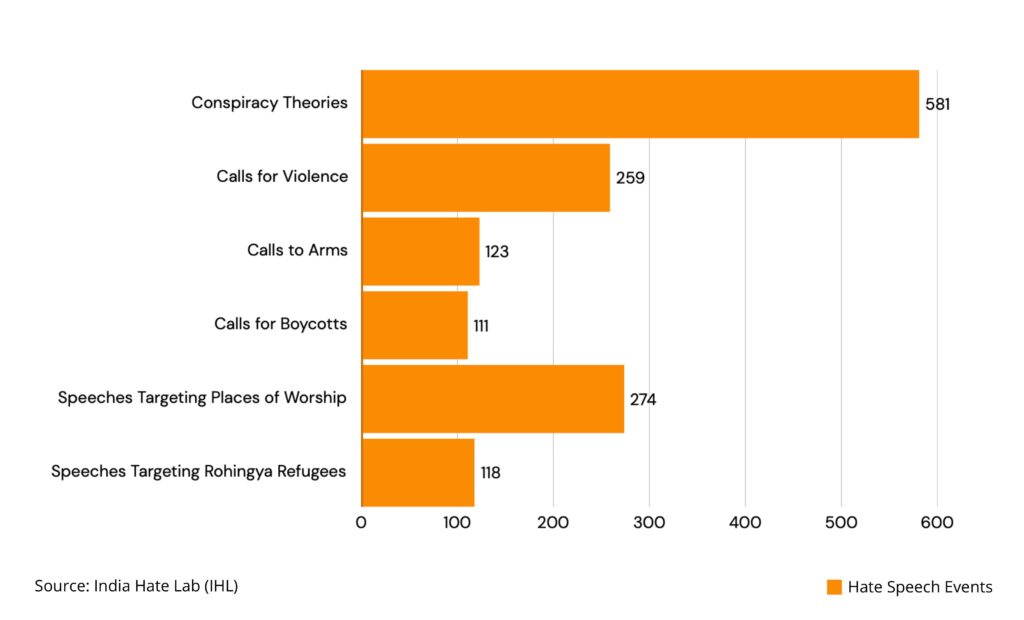
- 259 (22.2%) events featured dangerous speech, which included explicit calls for violence. Of these, 224 took place in states governed by the BJP or its allies or in union territories where law enforcement and public order fell under the jurisdiction of the BJP-led central government. Compared to 2023, dangerous speech events increased by 8.4%.
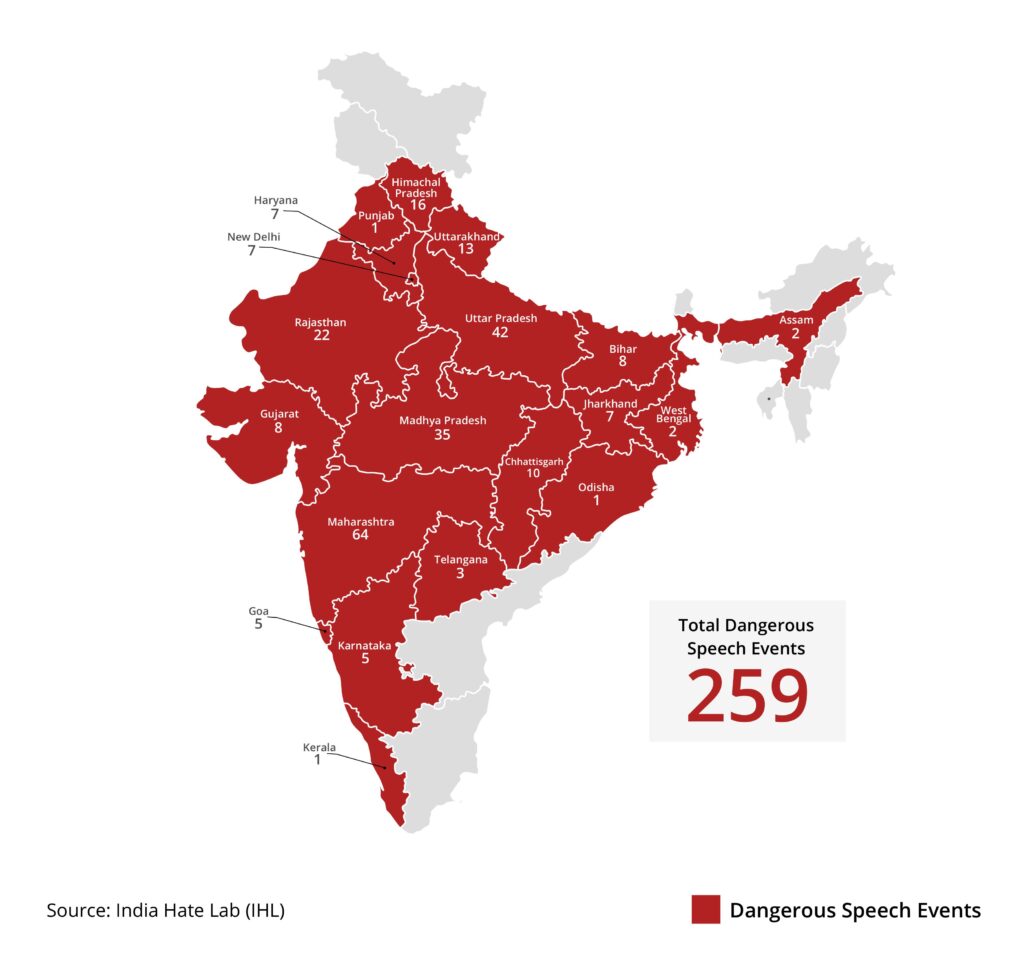
- Maharashtra BJP minister Nitish Rane (24 speeches), BJP Telangana legislator T. Raja Singh (22 speeches), and Antarrashtriya Hindu Parishad (AHP)-Rashtriya Bajrang Dal (RBD) chief Pravin Togadia (9 speeches) were among the key figures responsible for delivering dangerous speech in 2024.
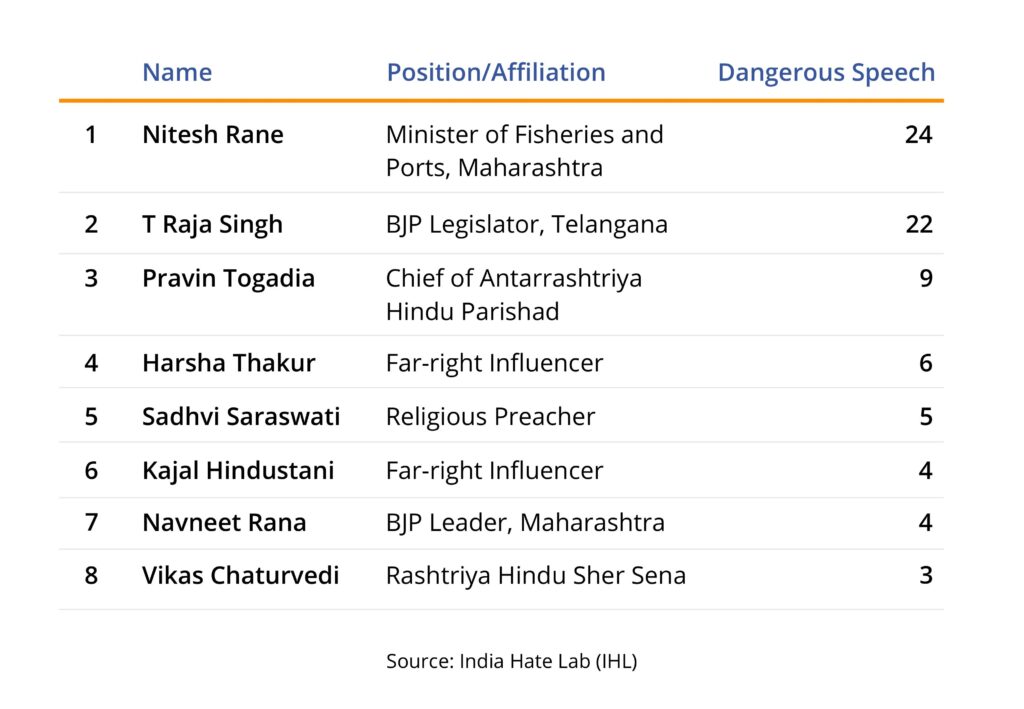
- 274 (23.5%) hate speeches called for the seizure, removal, or destruction of places of worship owned by Muslims or Christians. BJP politicians were responsible for 84 of these speeches, while 216 such gatherings were held in states governed by the BJP or its allies. Compared to 2023, hate speeches targeting places of worship rose by 62.1%.
- 123 (10.6%) hate speeches included an explicit call to arms, advocating for Hindus to procure and distribute weapons under the guise of “protection” from members of minority communities. Compared to 2023, such speeches rose by 32.3%.
- 111(9.5%) of hate speeches explicitly called for the social or economic boycott of minority communities, primarily Muslims. Compared to 2023, such speeches rose by 27.6%.
- 118 (10.1%) hate speech events in 2024 targeted the vulnerable Rohingya refugee community, while 182 (15.6%) speeches promoted the “Bangladeshi infiltrator” bogey. Hate speech against Rohingya refugees surged by 210% compared to 2023.
- 995 out of 1,165 hate speech events in 2024 were first shared or live-streamed on social media platforms, including Facebook, YouTube, Instagram, and X, with Facebook leading at 495 events.
- Of 259 recorded instances of dangerous speech, including explicit calls for violence, 219 were first shared or live-streamed on social media. Facebook accounted for 164 (74.9%), YouTube for 49 (22.4%), and Instagram for 6.
- As of February 6, 2025, only 3 of the reported videos have been removed by Facebook, while the remaining 98.4% continue to stay up across different platforms despite clear violations of community standards.
